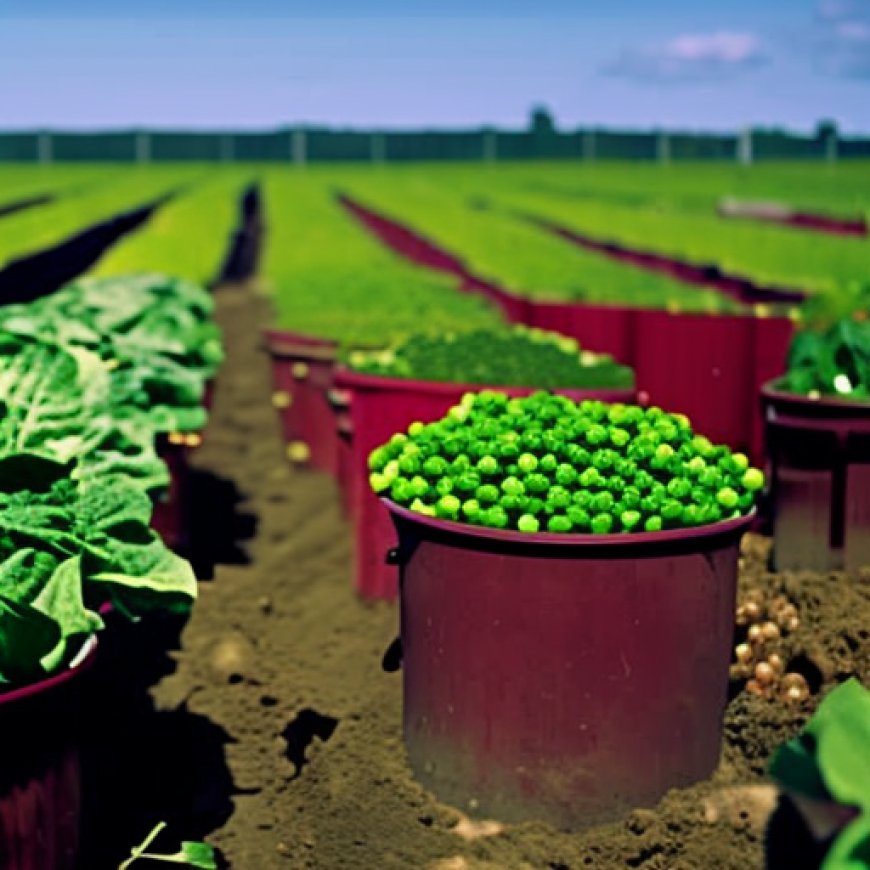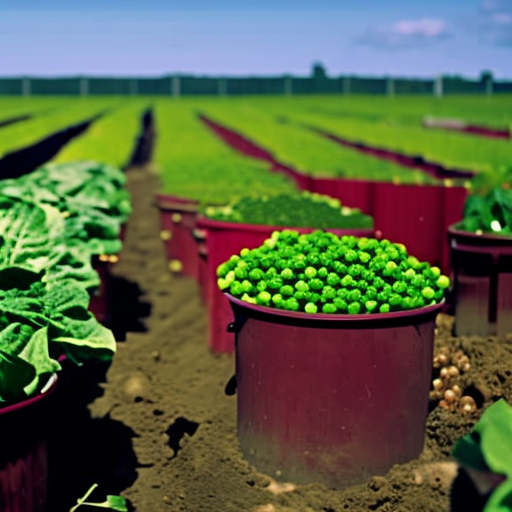Regenerative Agriculture Market: A Thriving Sector that Nurtures the Planet and Profits- By PMI
Regenerative Agriculture Market: A Thriving Sector that Nurtures the Planet and Profits- By PMI Yahoo Finance


Regenerative Agriculture Market Report
Introduction
Prophecy Market Insights latest research report on the Regenerative Agriculture Market provides a comprehensive analysis of the current market scenario, growth opportunities, challenges, and emerging trends. The report offers insights into the market’s size and share, key market players, distribution channels, and consumer preferences. It also examines the impact of the COVID-19 pandemic on the market and provides a detailed analysis of the competitive landscape, including strategic alliances, mergers, and acquisitions.
Regenerative Agriculture Market Overview
Regenerative agriculture market refers to the economic activities and opportunities associated with the adoption and promotion of regenerative farming practices. As the world faces increasing concerns about climate change, soil degradation, and the sustainability of conventional agriculture, the regenerative agriculture market is gaining momentum.
Key Highlights
- In March 2023, Diageo India launched a regenerative agriculture program in partnership with the Nature Conservancy India. The program’s original goal is to provide over 5000 small-holder farmers with best practices, information, and tools in order to transform agricultural practices. In the upcoming years, the corporation will further scale up this project as part of its long-term commitment.
Market Overview
Regenerative agriculture is a set of farming practices that aim to improve soil health, increase biodiversity, and enhance ecosystem services. These practices include cover cropping, no-till farming, composting, and rotational grazing. Regenerative agriculture has the potential to address many of the challenges facing modern agriculture, such as soil erosion, water pollution, and climate change.
| Report Attribute | Details |
| Regenerative agriculture market Value (2022) | US$ 12.6 Million |
| Regenerative agriculture market Projected Value (2032) | US$ 47.6 Million |
| Regenerative agriculture market CAGR (2022 – 2032) | 14.4% |
| No. of Pages | 172 |
| Report coverage | Revenue forecast, company share, competitive landscape, growth factors, and trends |
Key Market Drivers
- Growing consumer demand for sustainable food: Consumers are increasingly demanding food that is produced in a sustainable and environmentally friendly manner. Regenerative agriculture is seen as a way to produce food that is both nutritious and sustainable.
- Increased government support: Governments around the world are providing support for regenerative agriculture practices, recognizing the potential benefits for the environment and the economy.
- Growing awareness of the environmental benefits of regenerative agriculture: There is growing awareness of the environmental benefits of regenerative agriculture, such as improved soil health, increased biodiversity, and reduced greenhouse gas emissions.
Pros and Cons
Pros of Regenerative agriculture: Regenerative agriculture practices improve soil health, leading to increased organic matter, better nutrient retention, and reduced erosion.
Cons of Regenerative agriculture: Transitioning to regenerative practices may require an initial investment in education, equipment, and changes to farming methods.
Market Segmentation
- By Practice: Agroforestry, Aquaculture, Silvopasture, Holistic Planned Grazing, Pasture Cropping, Agroecology, Biochar, Pasture Cropping, and Others
- By Application: Nutrient Cycling, Biodiversity, and Carbon Sequestration
- By Region: North America, Europe, Asia Pacific, Latin America, and Middle East & Africa
Market Trends
- Integration of technology: Farmers are increasingly adopting technology to implement regenerative agriculture practices. This includes precision agriculture technologies, such as GPS-guided tractors and drones, which can help farmers to optimize their use of resources and improve soil health.
- Development of new regenerative agriculture products: Companies are developing new products to support regenerative agriculture practices. These products include biofertilizers, soil amendments, and cover crops.
- Increased demand for regenerative agriculture-certified products: Consumers are increasingly seeking out products that are certified to be produced using regenerative agriculture methods. This is driving demand for certified products and is creating new opportunities for businesses.
Competitive Landscape
The prominent players operating in the Regenerative Agriculture Market includes, Grounded, Unilever PLC, Nestle SA, Serenity Kids, Cargill Incorporated, Danone SA, General Mills, Inc., Soil Capital Belgium SPRL, Indigo Ag, Inc., and Bluebird Grain Farms.
Opportunities and Challenges
There are several opportunities for businesses in the regenerative agriculture market. These opportunities include:
- Developing new regenerative agriculture products and services
- Providing consulting and training services to farmers
- Partnering with retailers and distributors to sell regenerative agriculture-certified products
However, there are also some challenges facing the regenerative agriculture market. These challenges include:
- The high cost of implementing regenerative agriculture practices
- The lack of awareness of regenerative agriculture among consumers
- The limited availability of certified regenerative agriculture products
Conclusion
The regenerative agriculture market is a rapidly growing market with significant potential. Businesses that can address the challenges and capitalize on the opportunities in this market are well-positioned for success.
SDGs, Targets, and Indicators in the Article
1. Which SDGs are addressed or connected to the issues highlighted in the article?
- SDG 2: Zero Hunger – The article discusses regenerative agriculture practices that aim to improve soil health and increase food production sustainably.
- SDG 13: Climate Action – The article highlights how regenerative agriculture can address climate change concerns by reducing greenhouse gas emissions and improving soil health.
- SDG 15: Life on Land – The article mentions that regenerative agriculture practices can enhance biodiversity and ecosystem services.
2. What specific targets under those SDGs can be identified based on the article’s content?
- SDG 2.4: By 2030, ensure sustainable food production systems and implement resilient agricultural practices that increase productivity and production, that help maintain ecosystems, that strengthen capacity for adaptation to climate change, extreme weather, drought, flooding, and other disasters, and that progressively improve land and soil quality.
- SDG 13.2: Integrate climate change measures into national policies, strategies, and planning.
- SDG 15.5: Take urgent and significant action to reduce degradation of natural habitats, halt the loss of biodiversity, and protect and prevent the extinction of threatened species.
3. Are there any indicators mentioned or implied in the article that can be used to measure progress towards the identified targets?
- Indicator for SDG 2.4: Adoption of regenerative agriculture practices, such as cover cropping, no-till farming, composting, and rotational grazing.
- Indicator for SDG 13.2: Government support and policies for regenerative agriculture practices.
- Indicator for SDG 15.5: Increase in biodiversity and improvement in soil health due to regenerative agriculture practices.
Table: SDGs, Targets, and Indicators
| SDGs | Targets | Indicators |
|---|---|---|
| SDG 2: Zero Hunger | 2.4: By 2030, ensure sustainable food production systems and implement resilient agricultural practices that increase productivity and production, that help maintain ecosystems, that strengthen capacity for adaptation to climate change, extreme weather, drought, flooding, and other disasters, and that progressively improve land and soil quality. | Adoption of regenerative agriculture practices, such as cover cropping, no-till farming, composting, and rotational grazing. |
| SDG 13: Climate Action | 13.2: Integrate climate change measures into national policies, strategies, and planning. | Government support and policies for regenerative agriculture practices. |
| SDG 15: Life on Land | 15.5: Take urgent and significant action to reduce degradation of natural habitats, halt the loss of biodiversity, and protect and prevent the extinction of threatened species. | Increase in biodiversity and improvement in soil health due to regenerative agriculture practices. |
Behold! This splendid article springs forth from the wellspring of knowledge, shaped by a wondrous proprietary AI technology that delved into a vast ocean of data, illuminating the path towards the Sustainable Development Goals. Remember that all rights are reserved by SDG Investors LLC, empowering us to champion progress together.
Source: finance.yahoo.com

Join us, as fellow seekers of change, on a transformative journey at https://sdgtalks.ai/welcome, where you can become a member and actively contribute to shaping a brighter future.







